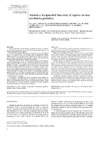Identificador persistente para citar o vincular este elemento:
https://accedacris.ulpgc.es/handle/10553/74347
| DC Field | Value | Language |
|---|---|---|
| dc.contributor.author | Anía Lafuente, B. J. | en_US |
| dc.contributor.author | Fernández-Burriel Tercero, Miguel | en_US |
| dc.contributor.author | Suárez Almenara, J. L. | en_US |
| dc.contributor.author | Betancort Mastrángelo, C. C. | en_US |
| dc.contributor.author | Guerra Hernández, L. | en_US |
| dc.date.accessioned | 2020-09-10T11:40:45Z | - |
| dc.date.available | 2020-09-10T11:40:45Z | - |
| dc.date.issued | 2001 | en_US |
| dc.identifier.issn | 0212-7199 | en_US |
| dc.identifier.other | Scopus | - |
| dc.identifier.uri | https://accedacris.ulpgc.es/handle/10553/74347 | - |
| dc.description.abstract | AIM: To ascertain the prevalence of anemia on admission to a nursing home, and to assess the relationship between the observed cases of anemia and the functional status of those subjects. METHODS: We studied 198 subjects: 82 men (41%) aged 75.8 +/- 8.8 years, and 116 women (59%) aged 78.2 +/- 8.3 years. Anemia was diagnosed according to the criteria of the World Health Organization. The classification as non-disabled, or physically or mentally disabled, was done according to the Scales of the Spanish Red Cross. RESULTS: Anemia was diagnosed in 36% of the males, being microcytic in 14%, normocytic in 83%, and macrocytic only in 3% of them. Among women there were 44% with anemia, which was microcytic in 16%, normocytic in 80%, and macrocytic in 4% of cases. The prevalence of anemia increased with age in both sexes. Among men, anemia was significantly associated (p = 0.013) with physical disability, whereas among women this association just fell off significance (p = 0.06). There was no association of anemia with mental disability. No association was found between serum concentrations of ferritin, vitamin B12, or folic acid, and the classification as non-disabled, or as physically or mentally disabled. CONCLUSIONS: Anemia is found in about 40% of the elderly on admission to our nursing home. Anemia is associated with older age and with physical disability, but not with mental disability. Whether anemia on admission entails a higher risk of disability onset during the stay in the nursing home remains to be elucidated. | en_US |
| dc.description.abstract | Objetivo: Establecer la prevalencia de anemia en ancianos al ingreso en una residencia, así como la relación de las anemias detectadas con el estado funcional de dichos sujetos. Método: Se estudiaron 198 sujetos: 82 varones (41 %) con 75,8±8,8años y 116 mujeres (59%) con 78,2±8,3 años. Se diagnosticó anemia según los criterios de la Organización Mundial de la Salud, y la clasificación en válidos o asistidos físicos o mentales se llevó a cabo mediante las Escalas de Incapacidad Física y Mental de Cruz Roja. Resultados: El 36% de los varones tenía anemia, que era microcítica en el 14%, normocítica en el 83% y macrocítica sólo en el 3%. Entre las mujeres había un 44% con anemia, que era microcítica en el 16%, nor-mocítica en el 80% y macrocítica en el 4% de los casos. La prevalenciade anemia aumentó con la edad en ambos sexos. Entre los varones la anemia se asoció significativamente (P=0,013) a la incapacidad física, mientras que en las mujeres dicha asociación estuvo en el límite de la significación (P=0,06). La anemia no se asoció a la incapacidad mental en ninguno de los sexos. No hubo asociación entre las concentraciones séricas de ferritina, vitamina B12 o ácido fólico y la clasificación en válidos y asistidos físicos o mentales. Conclusiones: Alrededor del 40% de los ancianos que ingresan en nuestra residencia presentan anemia. La anemia se asocia a la mayor edad y a la incapacidad física, pero no a la incapacidad mental. Queda por determinar si la anemia al ingreso condiciona un mayor riesgo de incapacitación durante la estancia en la residencia. | en_US |
| dc.language | spa | en_US |
| dc.relation.ispartof | Anales de Medicina Interna | en_US |
| dc.source | Anales de Medicina Interna [ISSN 0212-7199], v. 18 (1), p. 9-12, (Enero 2001) | en_US |
| dc.subject | 320107 Geriatría | en_US |
| dc.subject.other | Anemia | en_US |
| dc.subject.other | Incapacidad | en_US |
| dc.subject.other | Residencia geriátrica | en_US |
| dc.subject.other | Anciano válido | en_US |
| dc.subject.other | Anciano asistido | en_US |
| dc.subject.other | Disability | en_US |
| dc.subject.other | Nursing home | en_US |
| dc.subject.other | Non-disabled elderly | en_US |
| dc.subject.other | Disabled elderly | en_US |
| dc.title | Anemia e incapacidad funcional al ingreso en una residencia geriátrica | en_US |
| dc.title.alternative | Anemia and functional incapacity at admission to a geriatric home | en_US |
| dc.type | info:eu-repo/semantics/Article | en_US |
| dc.type | Article | en_US |
| dc.identifier.scopus | 0035222205 | - |
| dc.contributor.authorscopusid | 6601916532 | - |
| dc.contributor.authorscopusid | 6507688751 | - |
| dc.contributor.authorscopusid | 6506415234 | - |
| dc.contributor.authorscopusid | 6507353421 | - |
| dc.contributor.authorscopusid | 6507978241 | - |
| dc.description.lastpage | 12 | en_US |
| dc.identifier.issue | 1 | - |
| dc.description.firstpage | 9 | en_US |
| dc.relation.volume | 18 | en_US |
| dc.investigacion | Ciencias de la Salud | en_US |
| dc.type2 | Artículo | en_US |
| dc.utils.revision | Sí | en_US |
| dc.date.coverdate | Enero 2001 | en_US |
| dc.identifier.ulpgc | Sí | es |
| item.fulltext | Con texto completo | - |
| item.grantfulltext | open | - |
| Appears in Collections: | Artículos | |
SCOPUSTM
Citations
4
checked on Jun 8, 2025
Page view(s)
67
checked on May 11, 2024
Download(s)
71
checked on May 11, 2024
Google ScholarTM
Check
Share
Export metadata
Items in accedaCRIS are protected by copyright, with all rights reserved, unless otherwise indicated.
